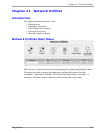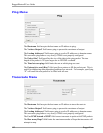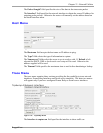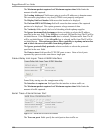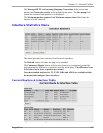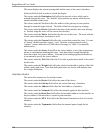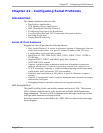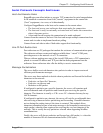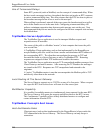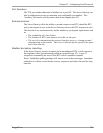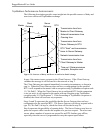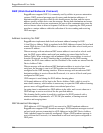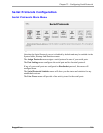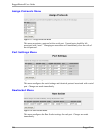
Chapter 22 - Configuring Serial Protocols
Serial Protocols Concepts And Issues
Host And Remote Roles
RuggedRouter can either initiate or accept a TCP connection for serial encapsulation.
It can establish a connection from field (“remote”) equipment to the central site
(“host”) equipment, vice versa, or bi-directionally.
Configure RuggedRouter at the host end to connect to the remote when:
• The host end uses a port redirector that must make the connection.
• The host end is only occasionally activated and will make the connection
when it becomes active.
• A host end firewall requires the connection to be made outbound.
Connect from the remote to the host if the host end accepts multiple connections from
remote ends in order to implement broadcast polling.
Connect from each side to other if both sides support this functionality.
Use Of Port Redirectors
Port redirectors are PC packages that emulate the existence of communications ports.
The redirector software creates and makes available these “virtual” COM ports,
providing access to the network via a TCP connection.
When a software package uses one of the virtual COM ports, a TCP connection is
placed to a remote IP address and TCP port that has been programmed into the
redirector. Some redirectors also offer the ability to receive connections.
Message Packetization
The server buffers received characters into packets in order to improve network
efficiency and demarcate messages.
The server uses three methods to decide when to packetize and forward the buffered
characters to the network:
• Packetize on Specific Character,
• Packetize on timeout and
• Packetize on full packet.
If configured to packetize on a specific character, the server will examine each
received character and will packetize and forward upon receiving the specific
character. The character is usually a <CR> or an <LF> character but may be any
ASCII character.
If configured to packetize on a timeout, the server will wait for a configurable time
after receiving a character before packetizing and forwarding. If another character
arrives during the waiting interval, the timer is restarted. This method allows
characters transmitted as part of an entire message to be forwarded to network in a
single packet, when the timer expires after receiving the very last character of the
message. This is usually the only packetizer selected when supporting ModBus
communications.
Finally, the server will always packetize and forward on a full packet, i.e. when the
number of characters fills its communications buffer (1024 bytes).
RuggedCom 199



